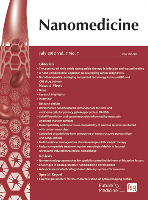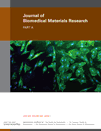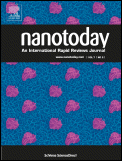
International Journal of Nanomedicine
Scope & Guideline
Unleashing the potential of nanotechnology for global health.
Introduction
Aims and Scopes
- Nanotechnology in Cancer Therapy:
The journal consistently explores the application of nanotechnology in cancer treatment, focusing on drug delivery systems, targeted therapies, and the development of novel nanomedicines that enhance the efficacy and reduce the side effects of existing treatments. - Nanomaterials for Drug Delivery:
A significant emphasis is placed on the design and optimization of nanocarriers, including liposomes, nanoparticles, and nanogels, that improve the bioavailability and therapeutic efficacy of drugs, particularly in challenging conditions like cancer and chronic diseases. - Biomaterials and Tissue Engineering:
Research on biomimetic materials and their applications in tissue engineering is a core area, with studies highlighting the potential of nanostructured materials to promote healing, regeneration, and integration with biological tissues. - Diagnostics and Imaging:
The journal also covers advancements in nanotechnology for diagnostic applications, including imaging agents and biosensors that utilize nanomaterials to enhance detection sensitivity for various diseases. - Extracellular Vesicles and Nanomedicine:
A growing focus is on the therapeutic potential of extracellular vesicles derived from stem cells and their role in drug delivery and regenerative medicine, showcasing innovative approaches to harness these biological nanocarriers.
Trending and Emerging
- Combination Therapies:
There is a growing trend towards the development of combination therapies that integrate various modalities, such as photothermal, photodynamic, and immunotherapy approaches, to enhance the overall efficacy of cancer treatments. - Smart and Responsive Nanocarriers:
Research is increasingly focused on smart nanocarriers that respond to specific stimuli (e.g., pH, temperature, or light) for controlled drug release, improving the precision of therapeutic interventions. - Nanoformulations for Chronic Diseases:
Emerging studies are exploring the application of nanotechnology in chronic disease management, including diabetes and neurodegenerative diseases, highlighting the potential of nanomedicine to address long-term health challenges. - Extracellular Vesicles in Drug Delivery:
The use of extracellular vesicles as nanocarriers for drug delivery is an emerging focus, driven by their natural biocompatibility and ability to target specific cells, making them a promising avenue for future research. - Personalized Nanomedicine:
The concept of personalized medicine is gaining traction, with research focusing on tailoring nanomedicine approaches to individual patient profiles, enhancing treatment efficacy and minimizing adverse effects.
Declining or Waning
- Traditional Chemical Synthesis Methods:
There has been a noticeable decline in studies relying solely on conventional chemical synthesis methods for nanomaterial production, as researchers increasingly favor greener and more sustainable approaches, such as biogenic synthesis. - General Antibacterial Applications:
Research focused solely on the antibacterial properties of nanomaterials, without specific applications in targeted therapies or complex disease models, appears to be waning as the field moves towards integrated approaches that address multiple therapeutic needs. - Non-Targeted Drug Delivery:
The emphasis on non-targeted drug delivery systems is decreasing, with a shift towards more sophisticated, targeted nanocarriers that enhance efficacy by specifically addressing the tumor microenvironment or other disease-specific markers. - Standalone In Vitro Studies:
There is a reduced frequency of standalone in vitro studies, as the journal increasingly favors research that includes in vivo validation or clinical relevance, demonstrating the effectiveness of nanomedicine in real-world applications.
Similar Journals

ACS Biomaterials Science & Engineering
Innovating the Intersection of Science and MedicineACS Biomaterials Science & Engineering, published by the American Chemical Society, serves as a premier platform for the latest advancements and research in the fields of biomaterials and biomedical engineering. With an impressive impact factor and a strong reputation reflected in its ranking—Q2 in Biomaterials and Q1 in Biomedical Engineering—the journal attracts a diverse and engaged readership. Since its inception in 2015, it has aimed to foster innovation by publishing high-quality research articles, reviews, and perspectives on the synthesis, characterization, and application of biomaterials. Researchers and professionals benefit from the journal's rigorous peer-review process and its focus on translational science, making it essential for those looking to stay at the forefront of biomaterials research. Located in Washington, DC, USA, the journal plays a pivotal role in connecting academic and industrial sectors, ultimately driving advancements that impact biomedicine and related fields.

Materials
Advancing knowledge in materials science and condensed matter physics.Materials is an esteemed journal published by MDPI, dedicated to advancing the fields of Condensed Matter Physics and Materials Science. With its commitment to Open Access since its inception in 2008, the journal has made significant strides in disseminating high-quality research globally, allowing researchers, professionals, and students easy access to cutting-edge studies without financial barriers. Hailing from Switzerland, the journal has shown remarkable growth and prominence, currently ranked in the Q2 quartile in its categories according to the latest assessments, which highlights its impact within the community. As the journal converges its focus from 2008 to 2024, it aims to continually foster a robust exchange of knowledge on innovative materials and their applications, thereby supporting the evolving landscape of science and technology. With an E-ISSN of 1996-1944 and a user-friendly platform, Materials is poised to be a leading choice for scholars eager to contribute to and engage with pioneering research.

Nanomedicine
Empowering Researchers with Groundbreaking Nanomedical DiscoveriesNanomedicine, published by Future Medicine Ltd, is a premier academic journal dedicated to the rapidly evolving field of nanotechnology in medicine. With an emphasis on innovative research and applications, this journal encompasses a broad spectrum of topics including bioengineering, biomedical engineering, and nanoscience, among others. Featuring an impressive Q1 ranking in Development and multiple Q2 rankings across significant categories, it serves as a pivotal resource for researchers and professionals aiming to stay at the forefront of advancements in these disciplines. While the journal is not open access, it is accessible through various institutional subscriptions, ensuring wide dissemination of cutting-edge findings. Notably, it has achieved substantial impact within the scientific community, indicated by its high rankings in Scopus and overall commitment to enhancing the understanding and application of nanomedicine. This journal is a vital conduit for fostering collaborations and innovations that transcend traditional medical paradigms.

ACS Applied Bio Materials
Connecting Science and Technology for Biomedical AdvancementsACS Applied Bio Materials is a leading academic journal published by the American Chemical Society, focusing on the innovative intersection of bioengineering and materials science. Since its inception in 2018, the journal has established itself as a pivotal platform for disseminating impactful research within the fields of Biochemistry, Biomaterials, Biomedical Engineering, and Chemistry, often ranked in the top tiers of these categories. With an impressive impact factor, it holds a Q2 ranking in both Biochemistry and Biomaterials, and a prestigious Q1 ranking in Biomedical Engineering and miscellaneous Chemistry, underscoring its significance in advancing knowledge and practices across these disciplines. The journal’s editorial commitment to high-quality, peer-reviewed research ensures relevance and rigor, appealing to a diverse audience of researchers, professionals, and students keen to explore breakthroughs in bio-related materials technology. The access options enhance its visibility and reach, allowing for a broader dissemination of studies that drive innovation and collaboration in biotechnology and material sciences. Located in the heart of Washington, DC, ACS Applied Bio Materials serves as a crucial resource for advancing the future of healthcare, engineering, and materials research.

JOURNAL OF BIOMEDICAL MATERIALS RESEARCH PART A
Advancing biomaterials for a healthier tomorrow.JOURNAL OF BIOMEDICAL MATERIALS RESEARCH PART A, published by WILEY, is a leading journal in the field of biomaterials and biomedical engineering, showcasing cutting-edge research that bridges the gap between material science and healthcare applications. With a robust 2023 impact factor reflecting its high-quality contributions, this journal is classified in the Q2 quartile for Biomaterials, Biomedical Engineering, and Ceramics and Composites, while achieving an impressive Q1 ranking in Metals and Alloys. The journal caters to a diverse readership, including researchers, professionals, and students, aiming to facilitate innovation and advancements in biocompatible materials and their applications in medical devices and tissue engineering. Access options for readers are available, ensuring the latest studies and findings are readily accessible to all stakeholders in this dynamic field. As it progresses towards its 2024 target, the JOURNAL OF BIOMEDICAL MATERIALS RESEARCH PART A continues to be an essential resource for anyone involved in the development and application of biomedical materials.

JOURNAL OF NANOBIOTECHNOLOGY
Navigating the Nexus of Nanotechnology and Biomedical EngineeringJOURNAL OF NANOBIOTECHNOLOGY is a distinguished academic journal published by BMC in the field of nanobiotechnology, focusing on the intersection of nanoscience, biotechnology, and biomedical engineering. Since its inception in 2003, this open-access journal has played a pivotal role in disseminating high-quality research, becoming a leading platform for innovators and scholars alike. With a remarkable impact factor and consistently ranking in the Q1 category across multiple fields—including Applied Microbiology, Bioengineering, and Pharmaceutical Science—the journal demonstrates its critical relevance and influence in advancing knowledge and applications in nanobiotechnology. Furthermore, its impressive Scopus rankings reflect its commitment to rigorously peer-reviewed content, making it a go-to resource for researchers, professionals, and students striving to push the boundaries of science. Given its broad scope, covering emerging trends and technologies, JOURNAL OF NANOBIOTECHNOLOGY continues to foster collaboration and innovation across multidisciplinary fields, inviting submissions from across the globe.

Materials Science & Engineering C-Materials for Biological Applications
Advancing biomaterials for a healthier future.Materials Science & Engineering C-Materials for Biological Applications is a premier journal published by ELSEVIER, dedicated to advancing the field of biomaterials through interdisciplinary research. With a robust ISSN of 0928-4931, this journal has made its mark in the realms of Chemical Engineering and Materials Science, achieving impressive Scopus rankings within its categories, namely Rank #16/151 in Bioengineering (89th percentile) and Rank #13/112 in Biomaterials (88th percentile). Although the journal's coverage in Scopus has been discontinued since 2021, it remains a critical resource for researchers, professionals, and students eager to explore innovative materials and their applications in biological contexts. The journal’s open access policy enhances its accessibility, fostering a global exchange of knowledge and inspiring future advancements in the field of materials science.

Advanced NanoBiomed Research
Pioneering Research in NanobiomedicineAdvanced NanoBiomed Research is a pioneering open-access journal committed to advancing the interdisciplinary field of nanobiotechnology, published by WILEY-V C H VERLAG GMBH. Since its inception in 2021, this journal has provided a platform for innovative research that bridges the gap between engineering, medicine, and materials science. With impressive rankings in Scopus, positioning it within the top quartiles of various categories, Advanced NanoBiomed Research aims to disseminate high-quality research that contributes to the understanding and application of nanomaterials in biomedical contexts. As it encompasses a wide scope—from applied microbiology to biomaterials—it serves as an essential resource for researchers, professionals, and students eager to explore the cutting-edge developments in the field. The journal promotes a collaborative environment where emerging ideas can flourish, ensuring that vital advancements in nanobiomedicine can be shared and built upon within the scientific community.

VIEW
Elevating Knowledge in Biomaterials and Biomedical Engineering.VIEW is a prestigious journal published by WILEY that focuses on the rapidly evolving fields of Biomaterials and Biomedical Engineering. Since its inception in 2020, VIEW has established itself as an open-access platform dedicated to disseminating high-quality research and innovation within these disciplines. With an impressive impact factor that places it in the Q1 category of both Biomaterials and Biomedical Engineering, VIEW ranks among the top journals in its field, boasting a 91st percentile ranking in Biomedical Engineering and an 85th percentile ranking in Materials Science. Researchers, professionals, and students are encouraged to utilize this invaluable resource, as it provides a comprehensive view of current advancements and future trends in biomaterial science and engineering. Positioned in the United Kingdom, VIEW operates as a vital scholarly communication link, fostering collaboration and knowledge sharing within an ever-growing global community.

Nano Today
Empowering innovation through cutting-edge research.Nano Today is a prestigious journal published by ELSEVIER SCI LTD that stands at the forefront of nanoscience and nanotechnology research. With an impact factor that underscores its significance, this journal has achieved remarkable rankings in several key categories as of 2023, including Q1 positions in Bioengineering, Biomedical Engineering, Biotechnology, Materials Science, and Pharmaceutical Science, making it an essential resource for scholars and professionals alike. ISSN 1748-0132 and E-ISSN 1878-044X, the journal serves as a vital platform for disseminating cutting-edge research findings and innovative applications in the field. Although open access options are not available, the journal's rich repository of peer-reviewed articles provides invaluable insights into the latest advancements in nanotechnologies. Based in the Netherlands, Nano Today not only connects a global network of researchers but also propels forward the conversation on the transformative potential of nanomaterials across multiple disciplines. With a commitment to advancing knowledge and fostering innovation, Nano Today is an indispensable tool for academics and practitioners dedicated to pushing the boundaries of scientific exploration.